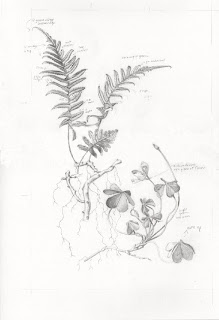Licorice Fern, Polypodium glycyrrhiza, forms a soft muff on the branches of trees in winter here in the Pacific Northwest. The wiry roots cause the rhizomes to cling to rocks and tree branches, usually under a soft coating of moss. In the winter when the trees are bare and colors are bleak, the green fluffy mantle of ferns is an especially welcome sight.
The Licorice Fern rhizomes were a food source for native peoples in the Pacific Northwest. They ate them raw as a treat, cooked them as a vegetable and used them as a medicine for colds and sore throat. When I nibbled on a rhizome it seemed more like a cross between grass and celery in flavor, but with a licorice after-taste. Not exactly delectable but maybe one can develop an appreciation for it over time. But I’ll leave that task to someone else…
The Redwood Sorrel, Oxalis oregana, grows as an evergreen ground cover on the forest floor. The new leaves are a soft spring green, but the older leaves darken and develop reddish undersides. It spreads by branching rhizomes. Native peoples in the area ate the leaves. I can imagine them nibbling on them as they strolled through the forest. I haven’t tried the leaves myself but I hear that they have a peppery taste. Actually, eating them is not recommended because they contain oxalic acid. I got my information about native food sources from the wonderfully informative book, Plants of the Pacific Northwest Coast by Pojar and Mackinnon.
The above painting is my submission for assignment 8 in the SBA course that I am taking. We were to depict a vegetable or a grouping of vegetables. I am sure that my choice of subject is atypical in the course but since I am focusing on plants native to my area, I naturally was drawn to food sources for Native Americans of the Pacific Northwest.
Just to give you an idea of my process, here is my initial drawing of the subject where I worked out the composition and studied the tones. After I am satisfied with the drawing, I transfer the outlines to my watercolor paper and proceed with the painting.
Finally, here is a photo I took of Licorice Ferns growing in an orchard of Filbert trees. You can see how frilly and decorative they look in the winter landscape.
I went out on a limb, so to speak, with this assignment! I wanted to focus on plants native to the region where I live because that is where my interests lie, and I thought it would be advantageous to start building my portfolio of native plant paintings during the course if I could. It was winter, so most vegetables were to be found in the market…or in the forest if I included plants used by Native Americans for food. The assignment instructions said that they welcomed depictions of unusual vegetables from overseas (of which I reminded my tutor when I sent in the painting) so I decided to take them at their word!
My tutor liked the composition and the 3D effect in my subjects. She said that the colors I used looked fresh and natural. She said that my technique was of a high standard.





 This blog is about my journey as a botanical artist--what I am learning, what inspires me and what I am currently drawing or painting. My desire is to continually hone my skills to better express my wonder and gratitude for the beauty of the creation around me in the Pacific Northwest (USA).
This blog is about my journey as a botanical artist--what I am learning, what inspires me and what I am currently drawing or painting. My desire is to continually hone my skills to better express my wonder and gratitude for the beauty of the creation around me in the Pacific Northwest (USA).
I love this Janene,and its so different to the usual veggies;congrats xx
Thanks Claire–glad you like it! I cleared the idea with my tutor first, just to be sure I wasn’t going tooo far from the norm!
Janene, this is lovely! I like the movement in the fern. I hadn’t realized that you were focussing on native plants. That’s a great idea. I’m learning a lot about local plants from you.
Thanks, Vicki! Great to hear from you.
I love this Janene. Ferns can be tricky things, but you seem to have had no trouble – it’s beautifully executed. A lovely unusual choice for a vegetable study. I am sure you’ll get a good mark with this piece. The composition flows and takes you eye across the paper. Thanks for showing us!
Thank you, Jessica! Actually I really struggled with the fern fronds–they are so complex! I have some ideas on how to simply the process next time so am not ready to give up on ferns yet though.
Stunning drawings Janene. You must have so much patience and control.
Thank you very much, Sue. I guess you can tell that I like detail!
This is a really beautiful piece Janene. Your choice is so unusual and a fab idea to think differently about what a vegetable is. The ferns are so delicate and fall so elegantly across the page.
Thanks, Sketchbook Squirrel!
These are beautiful Janene. We miss you at our sketchcrawls but I an see you are very busy doing these wonderful botanicals…and your joy in doing them is very evident in the finished product.
deb
Thanks Deb–I am hoping to join in on some crawls soon–I do miss seeing everyone! Glad you like my botanicals.
A very lovely composition with the two…I love seeing the drawing and the painting together. You’ve caught their grace and poetry!
Thank you very much, Elizabeth, what a nice complement!